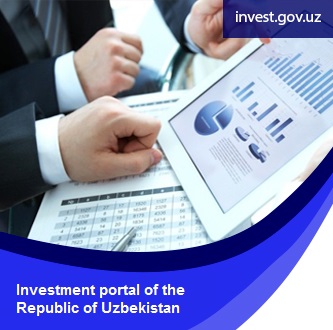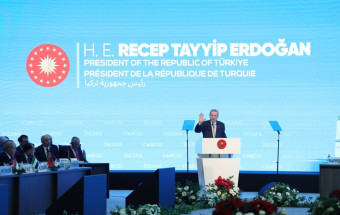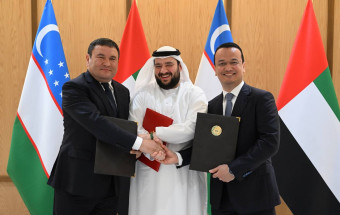The State symbols
STATE SYMBOLS
The Republic of Uzbekistan has its own state symbols - the flag, the emblem, and the anthem sanctioned by Law. The Constitution of the Republic of Uzbekistan. Article 5.
THE STATE FLAG OF THE REPUBLIC OF UZBEKISTAN

The Law about "The State Flag of the Republic of Uzbekistan" was adopted on November 18 in 1991 in the 8th session of the Supreme Council of Uzbekistan.
The flag of our country is a symbol of the sovereignty of the Republic. The national flag of the Republic represents the country internationally when official delegations from Uzbekistan visit foreign countries, as well as at conferences, world exhibition, and sports competitions.
The national flag of the Republic is a right-angled colored cloth of three horizontal stripes: blue, white and green.
Blue is the symbol of the sky and water, which are the main source of life. Mainly, blue was the color of the state flag of Temur.
White is the traditional symbol of peace and good luck, as Uzbek people say "Ok yul".
Green is the color of nature and new life and good harvest.
Two thin red stripes symbolize the power of life.
There is a new moon, which symbolizes the newly independent Republic.
There are twelve stars, which stand for spiritual sign. The stars also signify the historical traditions of the Uzbek people, as well as ancient solar calendar. A particular attention to twelve stars in the flag is explained yet by another suggestion, that in the states previously existed in the territory of modern Uzbekistan the scientific thought as "Astrology" had seen its rise. The stars in the Uzbek flag also point to the ancient roots of local culture, the aspirations of Uzbek people towards perfection and loyalty.
THE STATE EMBLEM

The Law about "The State Emblem" was approved by the 10-th session of the Supreme Council of the Republic of Uzbekistan on July 2, 1992.
The new state emblem of the Republic of Uzbekistan was created to reflect the many centuries of experience of the Uzbek people.
The state emblem of the Republic presents the image of the rising Sun over a flourishing valley. Two rivers run through the valley, representing the Syrdarya and Amudarya. The emblem is bordered by wheat on the right side and branches of cotton with opened cotton bolls on the left side.
The eight-angle star is at the top of the emblem, symbolizing the unity and confirmation of the republic. The crescent and star inside the eight-pointed star are the sacred symbols of Islam. The mythical bird Semurg with outstretched wings is placed in the center of the emblem as the symbol of the national Renaissance. The entire composition aims to express to desire of the Uzbek people for peace, happiness and prosperity. At the bottom of the emblem inscribed the word "Uzbekistan" written in Uzbek on a ribbon in the national colors of the flag.
NATIONAL ANTHEM
The Law "On national anthem of the Republic of Uzbekistan" was adopted on the December 10, 1992 at the 11th session of the Supreme Council of Uzbekistan.
Poem by A. Aripov
Music by M. Burkhanov
My country, sunny and free, salvation to your people,
You are a warmhearted companion to the friends
Flourish eternally with knowledge and invention,
May your fame shine as long as the world exists!
Refrain:
These golden valleys-dear Uzbekistan,
Manly spirit of ancestors is companion to you!
When the great power of people became exuberant
You are the country that amazes the world!
Belief of generous Uzbek does not die out,
Free, young children are a strong wing for you!
The torch of independence, guardian of peace,
Just motherland be eternally prosperous!
Refrain:
These golden valleys-dear Uzbekistan,
Manly spirit of ancestors is companion to you!
When the great power of people became exuberant
You are the country that amazes the world!
Geographical location
The Republic of Uzbekistan is located in Central Asia. According to natural and geographical conditions Uzbekistan is one of the most favorable regions in Central Asia. The territory of Uzbekistan is a peculiar combination of plains and mountain terrain.
Most of the territory of Uzbekistan is occupied by plains (about four-fifths of the territory). One of the main is Turanian plain. The east and northeast of the country are situated spurs of the Tien Shan and the Pamir mountains, here is the highest point in the country (4643 m). In the north central part of the territory of Uzbekistan is one of the largest deserts in the world - the Kyzyl Kum, west - the Karakum.
The mountains and foothills are about 1/5 part of the country. The east of the country is dominated by middle and high landforms. within the republic. Within the territory of the country there are the slopes or the closure of the West Tien Shan (Ugam, Pskem, Chatkalskiy, Kurama) and the Pamir-Alai (Zeravshan, Turkestan, Hissar, Kugitangtau Baysuntau). To the south and west, they gradually fall and into the plains. Stretch between mountains large cavities: Kashkadarya, Surkhandarya, Zarafshan, Samarkand are located. The largest intermountain trough - Ferghana hollow (valley) - lenght 370 km and width up to 190 km. On three sides of it are surrounded by the mountain ranges and is opened only from the west. On the border with Afghanistan is a vast Amu-Darya basin.
Territory
The Republic of Uzbekistan is situated between the rivers Amu Darya and Syr Darya, and covers an area of 448.9 thousand sq. km. The length of the territory of the Republic from west to east is 1 425 km from north to south - 930 km.
The territory in the north and north-east of the Republic of Uzbekistan borders with Kazakhstan, in the east and south-east with Kyrgyzstan and Tajikistan in the west with Turkmenistan, in the south with Afghanistan. The total length of the country border is 6 221 km The long border with Afghanistan is 143 km, with Kazakhstan - 2356.31 km, with Kyrgyzstan - 1476.12 km, with Tajikistan - 1283.2 km and Turkmenistan - 1831.49 km.
Population
According to The State Committee of the Republic of Uzbekistan on statistics, as January 1, 2021 the population of the republic is 34 558 900 people.
National holidays
 |
Day of defenders of the Native land (January, 14th) |
 |
Women's day (March, 8th) |
 |
Navruz (March, 21st) With the obtaining of the country's independence ancient customs and traditions of Uzbek people have revived, holiday Navruz also has been restored, and celebrating has got new scope and depth. It became a national holiday of friendship, unification, brotherhood of all people. In the bright dramatized representations of philosophic and poetic judgment of Navruz, it places in national history reveals. Now Navruz is celebrating annually in a grand manner. |
 |
Day of memory and honor (May, 9th) |
 |
Day of independence (September, 1st) Representatives of the various nations living in Uzbekistan, despite of a nationality, religion, the social status all actively celebrate a holiday in each street, the area and the people living in mahallas and in regions. |
 |
Day of teachers and educators (October, 1st) Pupils of schools and educational institutions deeply esteem all those who have given them the first vital knowledge. This day pupils with gratitude give flowers and gifts. |
 |
The Constitution Day (December, 8th) |
 |
Ramadan Hayit After performance of this ceremony last day the holiday which lasts three days - Ramadan Hayit begins. The first day of a holiday «Ramadan Hayit» is considered not working day. |
 |
Qurbon Hayit Religious holiday Qurbon Hayit this is the one of the greatest holidays in the World which is celebrated by Moslems. Sources of this holiday are ancient histories which are connected with prophet Ibrohim who in honor of the belief wished to sacrifice to "Allah" of the own son, but kind spirits have stopped his actions and instead of this have told to him to sacrifice animals such as sheep, camels, etc. The holiday lasts three days and these days all Moslems celebrate this holiday with their family with natives and close. Especially in these holidays people visit native and close, and also sick and requiring in the help. The first day of «Qurbon Hayit» is considered not off day. |





